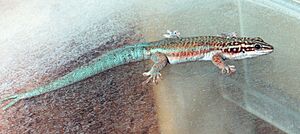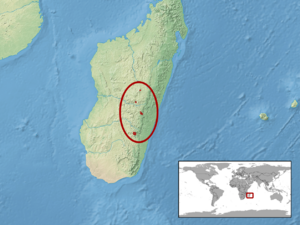Barbour's day gecko facts for kids
Quick facts for kids Barbour's day gecko |
|
|---|---|
 |
|
| Conservation status | |
| Scientific classification | |
| Genus: |
Phelsuma
|
| Species: |
barbouri
|
 |
|
The Barbour's day gecko (scientific name: Phelsuma barbouri) is a special kind of lizard that belongs to the gecko family. These geckos are only found in central Madagascar. They are active during the day, which means they are diurnal. You'll usually find them living on rocks. Barbour's day geckos enjoy eating insects and sweet nectar.
Contents
Who is Barbour?
This gecko is named after an American scientist named Thomas Barbour. He was a herpetologist, which means he studied reptiles and amphibians. The name barbouri honors him.
What Does It Look Like?
The Barbour's day gecko is a medium-sized gecko. It can grow to be about 13.5 centimeters (5.3 inches) long, including its tail. Its body is usually brownish-green or dark green.
Cool Markings
It has two dark brown stripes on each side of its body. One stripe runs along its back, and another runs along its side. These stripes go all the way from its head to its tail. Its legs are typically brown. The tail is a solid green color and is a bit flat.
Where Does It Live?
Barbour's day geckos live in the highlands of central Madagascar. You can find them in the Ankaratra Mountains. They live at high altitudes, from about 1,600 to 2,640 meters (5,250 to 8,660 feet) above sea level.
Its Home Environment
Unlike many other geckos, Barbour's day geckos live on the ground. They prefer to live on stones or rocks in savanna areas. Their home has a very tough climate.
Extreme Temperatures
The temperature changes a lot between day and night. It also changes a lot between different seasons. During the day, the temperature can reach up to 30°C (86°F). But at night, it gets cool and foggy.
What Does It Eat?
Barbour's day geckos eat different kinds of insects. They also enjoy other small invertebrates.
How Does It Behave?
These geckos often live in small groups. They have a cool trick to warm up. During the day, they flatten their bodies to soak up as much sun as possible. This helps them reach their favorite body temperature.
Color Changes
When it's night or early morning, the Barbour's day gecko looks dark. But when it's sunbathing, its body color becomes much brighter!
How Do They Have Babies?
Female Barbour's day geckos lay their eggs under stones. Sometimes, many females will lay their eggs in the same spot. This means you might find as many as 50 eggs together!
Hatching Time
If the temperature is around 28°C (82°F), the baby geckos will hatch in about 55 days. When they are born, these tiny geckos are only about 32 millimeters (1.3 inches) long.
Caring for Them as Pets
If you want to keep Barbour's day geckos as pets, they should live in pairs. They need a large terrarium with lots of places to hide. You can even keep a group of them together.
Setting Up Their Home
Their home should have an earth-based floor with many flat rocks. It's important to have special lights for them to bask under. During the day, the temperature should be about 29°C (84°F). At night, it should drop to around 20°C (68°F).
What to Feed Them
In captivity, they can eat many different insects. These include crickets, wax moths, fruit flies, mealworms, and houseflies.


